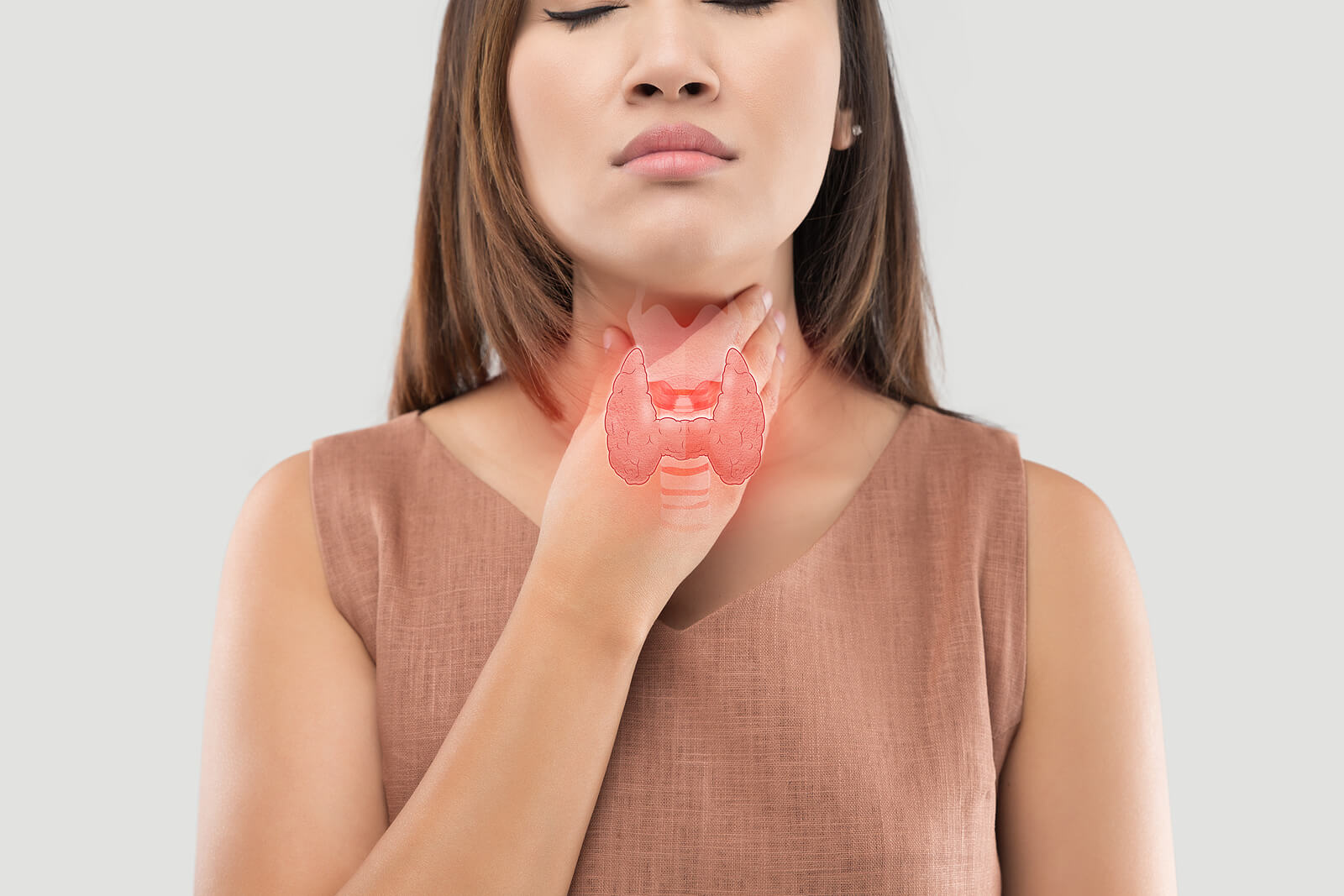What Is Thyrotoxicosis?

Thyrotoxicosis is defined as a clinical state in which the patient has very high concentrations of thyroid hormones (thyroxine and triiodothyronine) in the body.
People often confuse it with hyperthyroidism, but, in reality, this is just one of the many manifestations that it can have. It isn’t considered to be a disease, but, rather, a manifestation of an underlying cause.
The evidence indicates that its prevalence is 2% in women and 0.2% in men. In simple terms, a patient is diagnosed with thyrotoxicosis when there’s clinical evidence that their thyroid hormone levels are excessive. The next step is to identify what’s causing it. Let’s have a closer look.
Causes of thyrotoxicosis
Thyrotoxicosis can be caused by a primary cause in the thyroid gland or, by a secondary cause, such as high levels of thyroid-stimulating hormone (TSH). Although, in theory, there are dozens of catalysts that can throw hormone values off balance, studies have identified the following as the main culprits:
Graves’ disease

Graves’ disease is an autoimmune disorder that occurs when thyroid-stimulating immunoglobulin (TSI) combines and stimulates the thyroid-stimulating hormone (TSH) receptor right on the thyroid membrane. This results in excessive secretion. Most episodes of thyrotoxicosis are caused by Graves’ disease.
Toxic adenoma
The second most common underlying cause of this disorder is toxic adenoma, also known as an overactive thyroid nodule.
These are self-functioning cell masses that begin to secrete excessive levels of thyroid hormone. They usually develop within the gland and the reason for their appearance is still unknown.
Thyroiditis
Thyroiditis is an autoimmune disorder in which the body “attacks itself” and causes the inflammation of the thyroid gland. It’s a general term that meets many conditions. The American Thyroid Association recognizes Hashimoto’s disease, silent, acute, subacute, drug-induced, radiation, and postpartum thyroiditis.
Hyperthyroidism
Finally, the episodes can also be an initial manifestation of hyperthyroidism. Researchers agree that these are two different conditions. The three previous disorders can cause hyperthyroidism, although they can also be caused by an excessive intake of iodine and even by inadequate doses of medications for hypothyroidism.
Other possible causes of thyrotoxicosis are molar pregnancy, thyroid carcinoma, and Struma ovarii. However, these episodes are rare, and most of the time they can be explained based on the four previous conditions.
Symptoms of thyrotoxicosis
Thyrotoxicosis can manifest with or without symptoms. The frequency of these depends on how advanced the disorder causing the imbalance is. In its early stages, it usually goes unnoticed, while the signs are more evident when it has evolved to a higher level. In these cases, the patient may develop the following:
- Weight loss
- Heat intolerance
- Episodes of excessive sweating
- Anxiety
- Tremors
- Muscular weakness
- Fatigue
- Alopecia
- Irregular heartbeat
- Abdominal pain
- Depression
- Amenorrhea
Less frequently, gynecomastia, altered mental status, heart failure, impaired liver function, fever, swelling, neck pain, dysphonia, onycholysis and goiter may be experienced.
Diagnosis of thyrotoxicosis
Although the causes are multiple, all episodes of thyrotoxicosis are characterized by two circumstances: the serum value of thyroid-stimulating hormone (TSH) being low and the measurements of gland secretions (thyroxine and triiodothyronine) being high. These values can be determined by means of a serum test.
As a complement to this test, the specialist can perform a thyroid gammagraphy or radioactive iodine uptake to determine the causes more accurately. The physical examination, review of symptoms, and analysis of the medical history also help to complement the diagnostic process.
Treatment of thyrotoxicosis
Fortunately, thyrotoxicosis is a treatable condition. The specific approach the specialist will use depends largely on the underlying cause, as well as the symptoms the patient is experiencing. The most used methods are the following:
Drug therapy

Based on antithyroid drugs, drug therapy is the first option to reverse imbalances in hormone production. Evidence indicates that the protocol is to prescribe carbimazole (methimazole) or propylthiouracil.
The first is usually taken once a day, while the second is administered two or three times according to the criteria of the specialist.
The intake of this type of medication can be carried out without interruption for 12 or 18 months, after which the patient’s condition is assessed again.
Researchers suggest propranolol to control heart rate and thereby prevent anxiety and other signs.
Radioactive iodine
This consists of the oral intake of this compound that regularizes the functions of the thyroid gland. It’s an effective method which has been used regularly for over 60 years. As a side effect, it can cause the gland to go into a state of lethargy, which can lead to hypothyroidism.
Despite speculation or fear of patients by name, the evidence indicates that the therapy doesn’t pose any risk of developing cancer in the medium or long term.
Thyroidectomy
If the specialist deems it necessary, or the patient doesn’t respond to the first two treatments, a partial total gland removal surgery can be performed. This solution isn’t available to everyone, and is only reserved for specific cases. After all, any type of surgical intervention carries with it a number of risks.
In the event of a total excision, the patient must take hormonal supplements for life. If it’s a partial removal, then regular follow-ups should be carried out to determine the functioning of the gland.
In addition to this, and according to the patient’s condition, the specialist may suggest doing exercise and controlling stress levels as a method to alleviate symptoms. They may also suggest a meal plan to provide the necessary iodine values for the gland to function.
In any case, patients should be aware of the options and ask their trusted doctor about them.
Thyrotoxicosis is defined as a clinical state in which the patient has very high concentrations of thyroid hormones (thyroxine and triiodothyronine) in the body.
People often confuse it with hyperthyroidism, but, in reality, this is just one of the many manifestations that it can have. It isn’t considered to be a disease, but, rather, a manifestation of an underlying cause.
The evidence indicates that its prevalence is 2% in women and 0.2% in men. In simple terms, a patient is diagnosed with thyrotoxicosis when there’s clinical evidence that their thyroid hormone levels are excessive. The next step is to identify what’s causing it. Let’s have a closer look.
Causes of thyrotoxicosis
Thyrotoxicosis can be caused by a primary cause in the thyroid gland or, by a secondary cause, such as high levels of thyroid-stimulating hormone (TSH). Although, in theory, there are dozens of catalysts that can throw hormone values off balance, studies have identified the following as the main culprits:
Graves’ disease

Graves’ disease is an autoimmune disorder that occurs when thyroid-stimulating immunoglobulin (TSI) combines and stimulates the thyroid-stimulating hormone (TSH) receptor right on the thyroid membrane. This results in excessive secretion. Most episodes of thyrotoxicosis are caused by Graves’ disease.
Toxic adenoma
The second most common underlying cause of this disorder is toxic adenoma, also known as an overactive thyroid nodule.
These are self-functioning cell masses that begin to secrete excessive levels of thyroid hormone. They usually develop within the gland and the reason for their appearance is still unknown.
Thyroiditis
Thyroiditis is an autoimmune disorder in which the body “attacks itself” and causes the inflammation of the thyroid gland. It’s a general term that meets many conditions. The American Thyroid Association recognizes Hashimoto’s disease, silent, acute, subacute, drug-induced, radiation, and postpartum thyroiditis.
Hyperthyroidism
Finally, the episodes can also be an initial manifestation of hyperthyroidism. Researchers agree that these are two different conditions. The three previous disorders can cause hyperthyroidism, although they can also be caused by an excessive intake of iodine and even by inadequate doses of medications for hypothyroidism.
Other possible causes of thyrotoxicosis are molar pregnancy, thyroid carcinoma, and Struma ovarii. However, these episodes are rare, and most of the time they can be explained based on the four previous conditions.
Symptoms of thyrotoxicosis
Thyrotoxicosis can manifest with or without symptoms. The frequency of these depends on how advanced the disorder causing the imbalance is. In its early stages, it usually goes unnoticed, while the signs are more evident when it has evolved to a higher level. In these cases, the patient may develop the following:
- Weight loss
- Heat intolerance
- Episodes of excessive sweating
- Anxiety
- Tremors
- Muscular weakness
- Fatigue
- Alopecia
- Irregular heartbeat
- Abdominal pain
- Depression
- Amenorrhea
Less frequently, gynecomastia, altered mental status, heart failure, impaired liver function, fever, swelling, neck pain, dysphonia, onycholysis and goiter may be experienced.
Diagnosis of thyrotoxicosis
Although the causes are multiple, all episodes of thyrotoxicosis are characterized by two circumstances: the serum value of thyroid-stimulating hormone (TSH) being low and the measurements of gland secretions (thyroxine and triiodothyronine) being high. These values can be determined by means of a serum test.
As a complement to this test, the specialist can perform a thyroid gammagraphy or radioactive iodine uptake to determine the causes more accurately. The physical examination, review of symptoms, and analysis of the medical history also help to complement the diagnostic process.
Treatment of thyrotoxicosis
Fortunately, thyrotoxicosis is a treatable condition. The specific approach the specialist will use depends largely on the underlying cause, as well as the symptoms the patient is experiencing. The most used methods are the following:
Drug therapy

Based on antithyroid drugs, drug therapy is the first option to reverse imbalances in hormone production. Evidence indicates that the protocol is to prescribe carbimazole (methimazole) or propylthiouracil.
The first is usually taken once a day, while the second is administered two or three times according to the criteria of the specialist.
The intake of this type of medication can be carried out without interruption for 12 or 18 months, after which the patient’s condition is assessed again.
Researchers suggest propranolol to control heart rate and thereby prevent anxiety and other signs.
Radioactive iodine
This consists of the oral intake of this compound that regularizes the functions of the thyroid gland. It’s an effective method which has been used regularly for over 60 years. As a side effect, it can cause the gland to go into a state of lethargy, which can lead to hypothyroidism.
Despite speculation or fear of patients by name, the evidence indicates that the therapy doesn’t pose any risk of developing cancer in the medium or long term.
Thyroidectomy
If the specialist deems it necessary, or the patient doesn’t respond to the first two treatments, a partial total gland removal surgery can be performed. This solution isn’t available to everyone, and is only reserved for specific cases. After all, any type of surgical intervention carries with it a number of risks.
In the event of a total excision, the patient must take hormonal supplements for life. If it’s a partial removal, then regular follow-ups should be carried out to determine the functioning of the gland.
In addition to this, and according to the patient’s condition, the specialist may suggest doing exercise and controlling stress levels as a method to alleviate symptoms. They may also suggest a meal plan to provide the necessary iodine values for the gland to function.
In any case, patients should be aware of the options and ask their trusted doctor about them.
- Blick, C., Nguyen, M., & Jialal, I. Thyrotoxicosis. StatPearls. 2020.
- Carrera, C. B., Cabañas-Durán, M., Fernández, C. T., & García, J. R. Tirotoxicosis e hipertiroidismo. Medicine-Programa de Formación Médica Continuada Acreditado. 2020; 13(13): 718-726.
- Gronich N, Lavi I, Rennert G, Saliba W. Cancer Risk After Radioactive Iodine Treatment for Hyperthyroidism: A Cohort Study. 2020 Feb;30(2):243-250.
- Iagaru, A., & McDougall, I. R. Treatment of thyrotoxicosis. Journal of nuclear medicine. 2007; 48(3): 379-389.
- Pearce, E. N. Diagnosis and management of thyrotoxicosis. Bmj. 2006; 332(7554): 1369.
Este texto se ofrece únicamente con propósitos informativos y no reemplaza la consulta con un profesional. Ante dudas, consulta a tu especialista.







